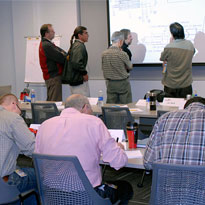LTE/SAE NGN Transport
- Course:LTE/SAE NGN Transport
- Course ID:LTE-SAE-NGN Duration:3 days Where: Your Office (7+ Persons)
- Download Course Description (PDF)
Available as a private, customized course for your group at your offices or ours and in some cases as a WebLive(TM) class.
Course Outline
- LTE/SAE Architecture
- Review of the components and functionality of LTE/SAE
- Requirements for interworking with other 3GPP RATs
- SAE: Will it support fixed and mobile IP connectivity?
- Providing carrier services to both fixed and mobile devices
- NGN Transport Architecture
- Components of NGN transport
- Pre-NGN services
- New services
- OSI layering
- MPLS
- MPLS: What it is, its benefits, and where to use it
- Layer 2 switching vs Layer 3 routing
- Principles of label switching:
- Terminology, components, label distribution
- Label switched paths: Establishment, operation, tunneling
- Label distribution methods
- Label assignment methods: Independent, ordered
- Impact of different label retention methods
- LDP, CR-LDP, RSVP, PIM
- Carrier-class MPLS
- MPLS-TE
- Traffic protection
- VPLS, H-VPLS
- Physical Medium Technologies for NGN Transport
- SDH
- Ethernet, Carrier grade Ethernet: Metro Ethernet
- CWDM, DWDM
- PONs
- Fiber to the premises
- SDH and Next Generation SDH
- Review of SONET and SDH
- Concatenation
- Can existing SDH be used in NGN transport?
- GFP
- Virtual concatenation
- LCAS
- Circuit Emulation Services
- Fiber Transport
- NGN requirements
- Transmitters and receivers
- Wavelength considerations
- WDM, CWDM, DWDM
- FTTx options
- PONs: APON, BPON, GPON, EPON
- Transition to Ethernet-based systems
- IEEE 802.3
- Optical Ethernet options
- EFM
- Gigabit, 10G and 100G Ethernet
- IEEE 802.1Q VLANs, Q-in-Q, MAC-in-MAC
- Aggregation and protection options
- Pseudo Wire Emulation
- Traditional carrier services
- Carrier services across an NGN
- PWE3 structure and requirements
- Encapsulation methods:
- FR, PPP, ATM, Ethernet over MPLS
- Examples of PWE3 emulation
- Opportunities
- Can SAE deliver? providing high bit rate broadband:
- To mobile devices
- To fixed devices
- Will this enable an operator to seamlessly provide all services to their users?
- Multimedia, TV/Video on Demand, Carrier Services
- At home and on the move
- Can SAE deliver? providing high bit rate broadband:
- Wrap-up
- Course recap and Q/A
- Evaluations
Course in a Nutshell
LTE is a fourth generation mobile communication technology standardized by the 3GPP which enables support for broadband connectivity to mobile devices, permitting the delivery of demanding multimedia information to any device, anywhere, anytime. In support of this, changes to the core network are also defined as System Architecture Evolution (SAE), providing an all-IP bearer platform for delivery of services.This course will provide you with a comprehensive understanding of the development, design, and capabilities of next generation transport technology options. The course will begin with a review of LTE/SAE and introduce the idea of the SAE delivering services to both fixed and mobile users. The focus of the course then shifts to transport options for the deployment of LTE/SAE as a next generation network infrastructure. Carrier-class MPLS is described in detail. Transport options for access, backhaul and core network are described in detail. The course finishes with an examination of the opportunities the evolved packet core and next generation transport technologies may permit.
Customize It!
This course can be customized to your needs at no additional cost. It is also available in expanded versions that include some of the topics covered in other courses listed in the Related Courses section.
Learn How To
- Describe the architectural structure of LTE/SAE and entity functionality
- Consider migration to SAE within your network
- Describe carrier-class MPLS operations
- Understand how broadband traffic can be carried over existing SDH/SONET
- Understand the various methods of broadband delivery over fiber
- Understand the use of PWE3 to deliver existing carrier services over NGN
- Consider which transport options are valid within your network
Aimed At
This course is aimed at a technical audience and is suitable for personnel at all levels from technician through manager who are involved in implementing LTE/SAE access, backhaul or core network technologies or who wish to keep up with future generation network technologies.
Prerequisites
Those wishing to take this course should have a basic knowledge of UMTS, HSPA, and LTE.

